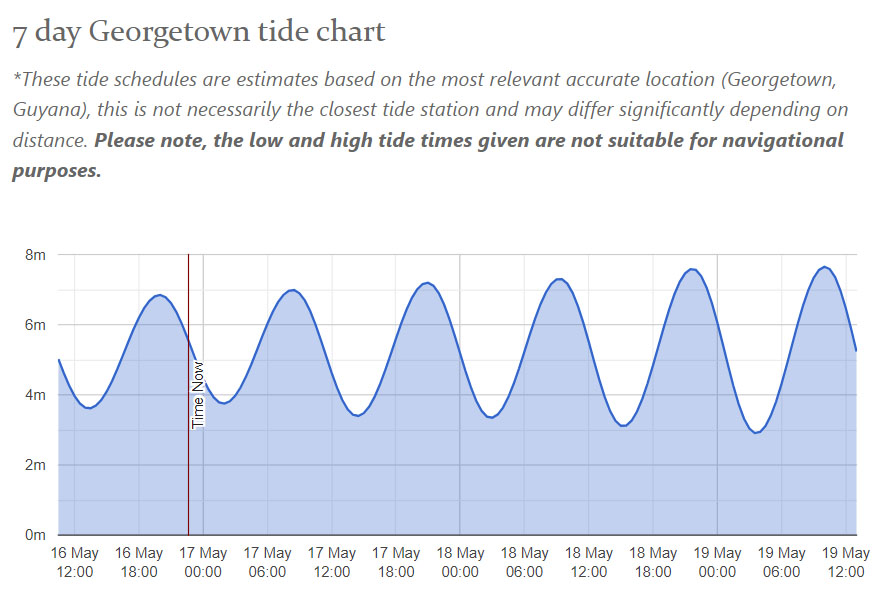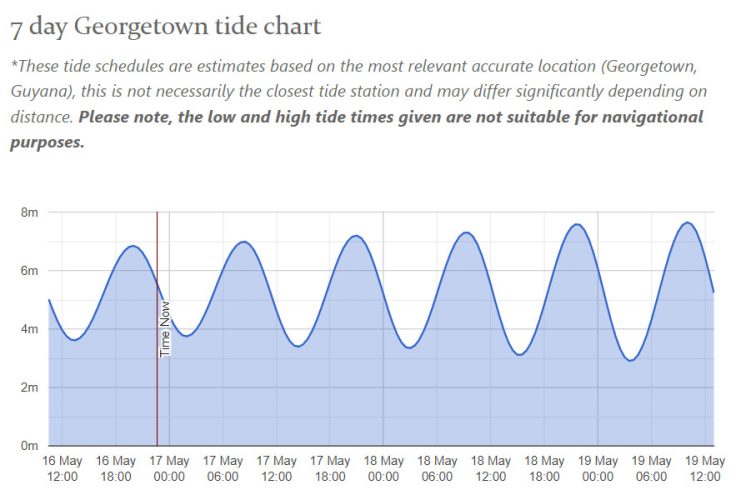Dear Editor,
Guyanese has had a very difficult period of blackouts recently in most areas. The dependence on fossil fuel with aging and insufficient generators are the primary causes. Hopefully, the power ship will temporarily alleviate the problem, until the gas to shore plant is operational. However, with the rapid growth of the economy, the gas may not be sufficient to match the energy demand. Hence, there must be a continual search for more reliable, clean renewable energy sources. Yes, hydropower is a good source, coupled with wind and solar. But, nothing is being said of tidal energy, an available source of emission free power.
Just a background. Tidal power is one of the earliest forms of renewable energy used by mankind. Once, tidal water wheels were used to crush grains. Tidal power generation is based on a simple physical fact. A tidal stream turbine can use the kinetic energy of the moving water to produce electricity. Many countries are harnessing tidal energy where the low and high tide variations and current velocity are sufficient to do so. Once the inflow/outflow of the tidal water can turn a turbine, electrical engineers should be able to use generators to produce power.
I have seen tidal variation of about 3 – 4 m, occurring four times per day on the coastlands of West Coast Demerara. The figure below shows the recent highs and lows at Georgetown (Source: www.tidetime.org/south-america/guyana/georgetown.htm). The information is generalised, but the difference in tidal level varies with locations, shore bed elevations and the time/day on the lunar calendar. For example, during spring tide at full moon, its higher. A comprehensive database of tidal variations is needed for the coastland to identify and effectively exploit tidal energy. The Government Hydrographic Survey department may want to start documenting tidal variations and associated velocities at specific potential locations for tidal power. Its my understanding that such data does not exist.
The MARAD data at Georgetown and Parika does not adequately represent what Guyanese know as the difference between low and high tides, particularly at Parika (Source: www.tide-forecast.com/locations/Parika-Essequibo-River-Guyana/tides/latest). Those of us who grew up in the area knows that Parika experience larger tidal fluctuations.
In bays, creeks and similar narrow passages to the Atlantic, this difference in low and high tides is even greater. For example, in the upper reaches of the Demerara River, the tidal variation and velocity of flow within the main channel are significantly greater than at Georgetown. Guyana should investigate this tidal variation to generate power. GPL and by extension, the Government should start identifying suitable locations and install turbines to generate small quantities of power. Cumulatively, this would add up to a major input to the national grid. Perhaps, larger than the power from the Gas to shore project.
Here is an example of a suitable location, Boeraserie Creek at De Kinderen, West Coast Demerara. In my youthful days, it was always a challenge to swim across the creek, within close proximity to the estuary with the Atlantic. There was a significant swift flow (greater than 3 m/s) in a confined area, occurring four times a day, corresponding to the tidal fluctuations. That flow can certainly turn a small turbine to produce at least 3 -5 MW of power, if the conditions there did not change with coastal modifications since I knew it. Why not start harnessing this power at Boeraserie and similar locations? De Kinderen and Meten-Meer-Zorg can use tidal power and avoid extended blackouts.
If there are insufficient locations such as Boeraserie, tidal lagoons are an equal option. A tidal lagoon is simply a rock-walled impoundment built along a shallow ocean shoreline. The lagoons trap the water during high tides and released it during low tides to create the required water level differential to turn a turbine. Only a small part of the bay can be used for the creation of a lagoon. Hence, there should be minimal impacts to the ecosystem, if it is design properly.
Canada is one of the country’s leading with the utilization of tidal power. The Bay of Funday with a significant tidal fluctuation is providing tidal power for most of the Atlantic Provinces in Canada. GPL and the Government should start by studying the Canadian example. I recognise that the Bay of Fundy has the largest tidal fluctuations in the world, capable of producing 7 Giga watts of power. However, the principle of using the tidal fluctuations is the same, at a smaller scale. In fact, most of the power for Novia Scotia and New Brunswick is derived from small bays within the Bay of Fundy.
It is acknowledged that there are some environmental issues with using turbines in tidal creeks and the creation of a tidal lagoon. Potentially, the turbines can affect navigation and the ecosystem. Nevertheless, it’s a source of energy production that has the least environmental impacts. Hopefully, GPL and the Government will investigate the feasibility of implementing at least one test location.
Sincerely,
Ram Dharamdial






